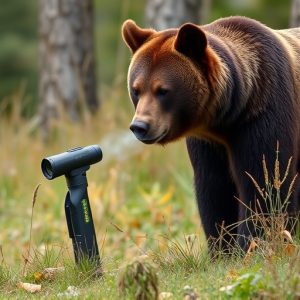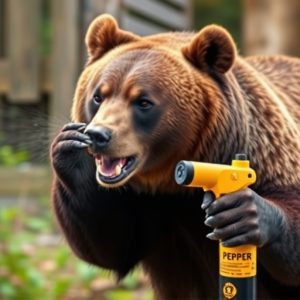Bear Spray: Understanding Cloud Dispersal for Safe Wildlife Encounters
Bear spray, effective against aggressive bears within 20-30 feet (6-9 meters), acts as a non-lethal…….
Bear spray, effective against aggressive bears within 20-30 feet (6-9 meters), acts as a non-lethal deterrent. Aiming for eyes and face creates an irritant cloud causing temporary blindness and breathing difficulties in bears. Optimal usage requires understanding weather, terrain, and application angle impacts on the bear spray cloud dispersal range of up to 30 feet (9 meters). Practicing activation techniques while keeping a clear view of the bear is crucial. In bear country, promoting peaceful coexistence through informed use of bear spray fosters safe interactions with these majestic creatures.
“In areas inhabited by bears, wildlife encounters can be both thrilling and dangerous. One crucial tool for enhancing safety during these interactions is bear spray. Understanding how bear spray works, its cloud dispersal range, and proper usage techniques is essential for anyone adventuring in bear country. This article explores the vital role of bear spray in ensuring safe coexistence with these majestic creatures, focusing on cloud dispersal range and offering practical tips for effective usage.”
- Understanding Bear Spray: A Vital Tool for Wildlife Encounters
- How Bear Spray Cloud Dispersal Range Impacts Safety
- Effective Usage and Safety Tips for Optimal Protection
- The Role of Bear Spray in Coexistence with Wild Bears
Understanding Bear Spray: A Vital Tool for Wildlife Encounters
Bear spray is a crucial tool for individuals navigating wild environments and encountering bears. This non-lethal self-defense mechanism creates a cloud of irritants that can deter aggressive behavior, providing valuable time for escape or retreat during potentially dangerous situations. The primary active ingredient in bear spray is capsaicin, the same compound that makes chili peppers spicy, which causes temporary blindness, coughing, and difficulty breathing in bears, allowing humans to safely move away.
The effectiveness of bear spray depends on several factors, including proper usage techniques and the proximity of the spray cloud dispersal range—typically around 20-30 feet (6-9 meters). Users must aim for the eyes and face of a charging bear, creating a dense cloud that ensures maximum exposure to the irritants. Regular training and familiarity with this equipment are essential, as proper application can make all the difference in successful outcomes during wildlife encounters.
How Bear Spray Cloud Dispersal Range Impacts Safety
The effectiveness of bear spray in ensuring safety during wildlife encounters relies heavily on its cloud dispersal range. Bear spray is designed to create a barrier of capsaicin, the active ingredient, that irritates a bear’s eyes and respiratory system when inhaled. The ideal bear spray cloud should cover a sufficient area around the user to provide time for escape or de-escalation without direct contact. Cloud dispersal refers to how far and wide the spray mist spreads upon activation, and this range varies among different products.
Factors influencing bear spray cloud dispersal include weather conditions, terrain, and the angle of application. In ideal conditions, a good quality bear spray can project a protective cloud up to 30 feet (approximately 9 meters) in all directions. However, in windy or hilly areas, the range may be reduced significantly. Understanding the specific bear spray cloud dispersal range recommended by the manufacturer is crucial for users to make informed decisions and effectively prepare for potential encounters with bears.
Effective Usage and Safety Tips for Optimal Protection
When using bear spray, understanding its cloud dispersal range and effective usage is paramount for optimal protection. Aim for the eyes and face of the bear, creating a dense cloud of spray. The ideal distance for successful deployment is typically within 20 to 30 feet (6 to 9 meters), though some modern bear sprays can be effective up to 40 feet (12 meters). Remember, this range varies based on factors like wind conditions and the specific product’s aerosol characteristics.
Safety tips include keeping a clear line of sight between you and the bear, ensuring your back is against a solid barrier, and never turning your back on the animal. It’s crucial to practice and familiarize yourself with the spray’s activation mechanism before venturing into potential bear country. Keep your bear spray readily accessible, preferably in an easily reachable pocket or belt holster, for quick deployment when needed.
The Role of Bear Spray in Coexistence with Wild Bears
In areas where wild bears roam, promoting peaceful coexistence is essential for both humans and wildlife. Bear spray stands as a critical tool in this effort, offering a non-lethal means of deterring aggressive bear encounters. When used appropriately, bear spray creates a protective barrier by releasing a cloud of repellent chemicals into the air, effectively dispersing the bear without causing harm.
The bear spray cloud dispersal range varies depending on factors like can size, concentration, and weather conditions. Typically, a well-aimed spray can create a protective zone of up to 30 feet (9 meters) in diameter. This range allows individuals or groups to maintain a safe distance from bears, providing precious time for retreats or de-escalation strategies. Understanding the cloud’s reach empowers outdoor enthusiasts and locals alike to make informed decisions during potential bear encounters, fostering a harmonious relationship with these majestic creatures in their natural habitat.
Bear spray is a powerful tool for self-defense during wildlife encounters, especially when used correctly. Understanding the cloud dispersal range of bear spray ensures its effectiveness in keeping you safe at a distance. By following safety tips and practicing responsible usage, individuals can coexist with wild bears more harmoniously. This article has highlighted the importance of bear spray as a game-changer in navigating the unpredictable nature of these majestic creatures, ultimately emphasizing the value of staying protected while appreciating their presence in our shared environment.


